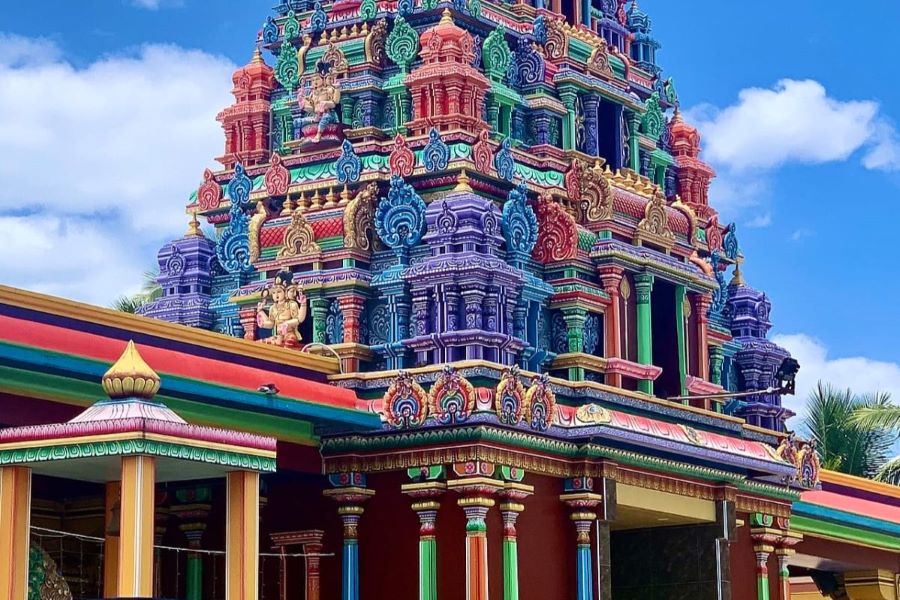Breaking stereotypes: Not all Hindus Are Indian
A close-knit community, the Fijian Hindus work hard to pass on their faith and culture to the next generations.
 Sri Siva Subramaniya Temple is a Hindu temple in Nadi, Fiji is the largest Hindu temple in the Pacific / Wikipedia
Sri Siva Subramaniya Temple is a Hindu temple in Nadi, Fiji is the largest Hindu temple in the Pacific / Wikipedia
Over the past year, in my new role as a California Regional Director at the Hindu American Foundation, I've had the privilege of engaging with global Hindus.
One such engagement has been with the Californian Fijian Hindu communities in our ongoing showcase of the global Hindu diaspora. Recently, we collaborated with Australian Fijian Hindu movie maker Ravi Chand of Warrior Tribe Films. Through his movies, he narrates refreshingly realistic, humane stories of Hindus and their struggles in preserving their faith and culture.
'Namaste Yoga', his latest production, is a poignant movie that sheds light on the whitewashing of yoga and the struggles of its indigenous practitioners, an Australian Hindu family. The film aims to promote a deeper understanding of the Hindu faith and culture through its powerful storytelling.
HAF California spearheaded the screenings at iconic Hindu temples run by Fijian communities, at Hayward and Sacramento, attracting interested audiences across ages. Virtual Q&A sessions gave the attendees a unique opportunity to interact with the movie maker and gain deeper insights into the movie's themes and production. The sessions were filled with thought-provoking questions and engaging discussions, which further enhanced the movie experience. A true global celebration indeed!
I too learned at length about the Fijian Hindu culture and its immense pride. A close-knit community, the Fijian Hindus work hard to pass on their faith and culture to the next generations.
Known as 'Girmityas', they originate from Bihar, India. Their extreme hardships as indentured laborers are slowly being unearthed. This discovery has been a profound and enriching experience for me, deepening my appreciation for the resilience and strength of the Fijian Hindu communities.
Thanks to this project, I received the gift of meeting Sandeep Singh, a HAF Dharma Ambassador, whose instrumental role in the success of the Sacramento movie screening is commendable. Here, I share a glimpse into his fascinating Fiji Hindu identity.
Tell me about your Fiji Hindu identity.
Growing up in Fiji, I listened to my Aaji's (paternal grandmother) stories about my ancestry and faith. We learned early on that life isn't just about oneself but also about understanding and building a connection with nature and God. As kids, we eagerly awaited festivals like Ram Navami, Krishna Janmashtami, and Holi. My favorites were Navratri and Diwali. Our childhood experiences carved us into proud Hindus. I also questioned the meaning and significance of many rituals and practices, like decorating a kalash in a specific way, cooking prashad with a particular recipe, or lighting the diya. My identity as a Fiji Hindu connects me to my family lineage, thus developing my relationship with the Supreme.
What does it mean to be a Fiji Hindu in the US?
Being a Fiji Hindu in the US means having the freedom to express my religious practices and beliefs through learning kirtans, chanting mantras and Vedic hymns, listening to pravachans, and gaining scriptural knowledge from a guru. Here, I can freely pursue the main Hindu goal of being in harmony with myself while inspiring others. Also, being a Fiji Hindu in the US is the same as any other global Hindu since our ancestors followed the same dharmic texts such as Ramayan, Bhagavatam, and Upanishads.
How do you pass on your Fiji Hindu identity to your kids?
I inspire my kids through my actions as a Hindu at home and outside. We learn together as a family, setting time aside for God by reading the Geeta and Puranas, singing kirtans, performing Shiva abhishekam, and visiting the temple. Most importantly, I talk to my kids to understand their experiences as Hindu Americans. Finally I teach them the ideology of “Vasudaiva Kutumbakam” (The world is one family).
In short, I’ve loved my interactions with fellow Hindus like Sandeep Singh, realizing our commonalities despite having varied global origins. It also busted the common myth that all Hindus are Indians, highlighting the rich diversity amongst the global Hindus and the strong thread of shared values and beliefs uniting us all.
Our ancestors have immigrated widely through choice or force, joy or regret, comforts or adversities. But ultimately, they have held onto their religious, cultural, and spiritual identities, thus surviving and flourishing gloriously.
ADVERTISEMENT
ADVERTISEMENT
E Paper
Video

 Sangeetha Shankar
Sangeetha Shankar.jpg)

.jpg)

.jpg)


.jpg)

.jpg)

Comments
Start the conversation
Become a member of New India Abroad to start commenting.
Sign Up Now
Already have an account? Login